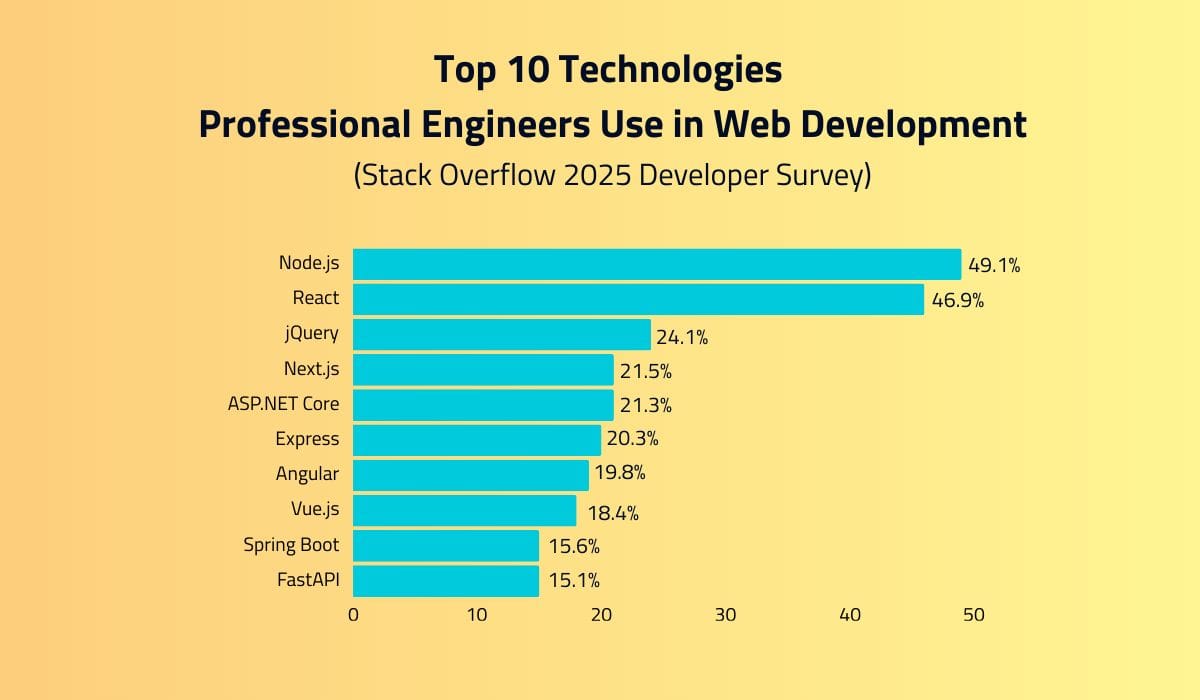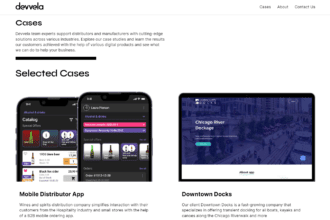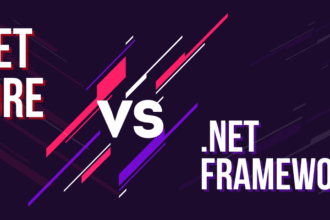The latest Stack Overflow 2025 Developer Survey provided a revealing look into the tools and trends shaping the tech industry. Among other things, it highlights the most popular frameworks and technologies currently used in web development.
Let’s dive into the top 10 most popular web development technologies used by professional developers, as we try to find out what makes each of them so popular.

Node.js
Node.js remains a frontrunner in the web development space, with nearly 50% of respondents working with this technology. That’s hardly surprising. The best thing about Node.js is that it offers a unified language stack that enables developers to use JavaScript on both the front-end and back-end. This is one of the primary reasons it is used by startups as well as big companies like Netflix, LinkedIn, and Trello.
Its event-driven architecture allows Node.js to handle a large number of concurrent connections efficiently on a single thread. As a result, it’s easy to ensure scalability and keep applications responsive even under heavy traffic. These are essential features for highly demanded solutions in the market, such as real-time chats, streaming platforms, and collaborative applications.
React
React consistently ranks at the top in developer surveys as one of the most popular front-end libraries. Its component-based architecture allows engineers to speed up the development process by building reusable UI elements.
Backed by Meta and a large open-source community, React offers a rich ecosystem of tools and libraries that make building complex web interfaces easier. It’s the go-to technology for projects like Facebook, Instagram, WhatsApp, and thousands of startups, thanks to its performance and flexibility.
jQuery
Although older than many modern frameworks, jQuery remains widely used because of its simplicity and versatility. It smooths out browser inconsistencies and makes DOM manipulation, event handling, and animations straightforward.
Many legacy projects and websites still rely on jQuery. Its lightweight footprint makes it a quick solution for small applications. The huge plugin ecosystem and a low learning curve contribute to its popularity despite the rise of newer tools.
Next.js
Next.js has quickly become a favorite for building modern web applications with React. Its key strengths lie in server-side rendering, static site generation, and built-in optimizations for performance and SEO. Developers appreciate its balance between flexibility and convention, as well as its seamless integration with Vercel’s hosting platform.
Popular platforms such as TikTok, Hulu, and Notion use Next.js for their apps, contributing to its rising popularity
ASP.NET Core
ASP.NET Core is known for strong performance, security, and enterprise-level reliability. Developers benefit from seamless integration with Microsoft Azure, powerful tooling in Visual Studio, and first-class support for modern development practices.
Many enterprise solutions, government systems, and large-scale corporate apps rely on ASP.NET Core. This makes it especially popular among developers working in enterprise environments.
Express
Express is a minimal and flexible Node.js framework that simplifies building web servers and APIs. Its unopinionated design gives developers the freedom to structure apps their way, while middleware support makes it highly customizable.
Express serves as the backbone for many web projects, including the MERN stack (MongoDB, Express, React, Node.js), which is widely adopted by startups and product teams. Its simplicity, speed, and massive community support explain why it remains one of the most popular backend frameworks.
Angular
Angular is a full-featured framework for building dynamic single-page applications. It offers powerful features such as two-way data binding, dependency injection, and a strong CLI for project scaffolding and management. Angular is favored for building large, complex applications where structure and maintainability are crucial.
Companies like Google, Microsoft, and Deutsche Bank use Angular in their production systems, which helps sustain its popularity in the enterprise and government sectors.
Vue.js
Vue.js is well-known for its simplicity, gentle learning curve, and flexibility. It combines the best ideas of Angular and React while keeping the syntax approachable for beginners. Software engineers often choose Vue for creating modern, reactive interfaces with minimal boilerplate.
Popular platforms like Alibaba, Xiaomi, and GitLab have adopted Vue, showing its scalability from small projects to enterprise-level apps. Its growing community and ease of integration continue to drive its growth.
Spring Boot
Spring Boot streamlines the development of Java-based applications by reducing configuration overhead and providing production-ready defaults. It’s part of the larger Spring ecosystem, which is trusted by enterprises worldwide.
Developers like Spring Boot’s microservices support, scalability, and integration capabilities with databases, messaging systems, and cloud platforms. Major companies like Netflix, Amazon, and eBay rely on Spring Boot for mission-critical services.
FastAPI
Stack Overflow noted that FastAPI’s gain in the survey results is one of the most drastic changes in the web frameworks ecosystem. FastAPI’s popularity comes from its speed, ease of use, automatic documentation, and strong async support. This makes it a great choice for modern APIs, including those used to integrate AI models.
FastAPI is already being used in production systems of companies like Uber and Microsoft, demonstrating its growing adoption in commercial applications.








